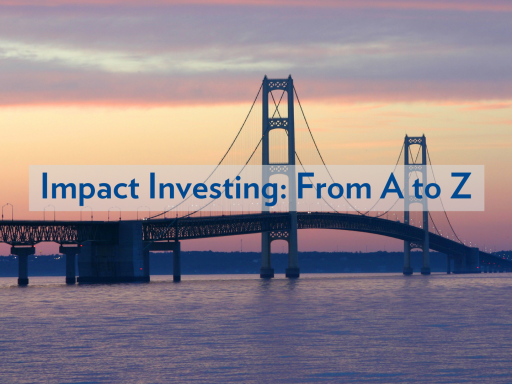Reflections on ESG Backlash and the Role of Philanthropy
By Jennifer Oertel, CMF's Impact Investing Expert in Residence
During the past two years, you may have seen headlines around “ESG Backlash” and “Woke Capitalism.” These and other terms like them have been politicized along party lines, and Florida even adopted legislation forbidding ESG considerations when investing any state funds, such as pension funds, and a few other states soon followed that lead.
As our partners at The Johnson Center for Philanthropy explain in a 2023 post on the issue, the acronym “ESG” stands for “environmental, social, and governance” – general categories covering the range of criteria that can be used to help determine if an investor should invest in or divest from that company. As author Michael Moody explains, “ESG is an increasingly relevant issue in philanthropy because any philanthropic organization that has an endowment must make choices about how that endowment is invested — or at least work closely with the experts who make those choices.”
Some speculated that the rhetoric around sustainability and ESG as a lens to consider investment strategies would spill over into impact investing. However, ESG and impact investing are far from gone.
From 2021 through 2023, the S&P ESG 500 index continued outperforming the S&P 500 index. More than half of the anti-ESG legislation proposed by states failed, and other states enacted pro-ESG legislation. Further, according to the Global Impact Investing Network (GIIN) 2023 GIINsight series, data from 308 impact investors globally showed that investor allocations to impact strategies have increased, with significant growth in public markets, housing and technology investments, reflecting broader global trends.
Impact investing remains an effective tool for achieving the United Nations Sustainable Development Goals (SDGs) by bridging the billions (in philanthropic capital available) to trillions (of dollars needed to meet the goals). And, we know the practice of impact investing continues to grow year after year. The GIIN 2022 market sizing report estimates the current size of the global impact investing market to be $1.2 trillion.
Admittedly, skeptics of ESG and impact investing do have a point. Even proponents of the practices acknowledge that “greenwashing” and “impact washing” exist – terms referencing intentionally deceitful marketing that exaggerates an organization’s current or past practices to appear more environmentally friendly. There are few proposed and no universally agreed upon impact measurement metrics, let alone a definition of impact, leaving the field open to vulnerability.
Nonetheless, as leaders in philanthropy, which is about “acts of love for humankind,” it is imperative that foundations continue to examine their opportunities and responsibilities to sharpen their practices – including and especially our investments – through the lens of diversity, equity and inclusion, and the generational work of sustainability.
Given these challenging dynamics, what is an impact investor to do? Headway is being made, and resources are available to support you! For example, GIIN has its IRIS system that provides standards and tools by which to measure, manage and optimize impact to ensure a minimum level of consistency in users’ impact claims and performance. A standard system would make it easier for investors to compare the impact of various investments when making and evaluating investment decisions.
Last January, the European Union adopted the Corporate Sustainability Reporting Directive, which requires EU and non-EU companies with activities in the EU to file annual sustainability reports alongside their financial statements, prepared in accordance with European Sustainability Reporting Standards. In 2022, the Securities Exchange Commission proposed a rule that would enhance and standardize climate disclosure requirements provided by public companies. These and similar laws provide further evidence that sustainability is and will remain a topic of consideration, even in the for-profit landscape. The final rule is expected to be enacted sometime this spring.
In addition, there are many free tools that can be used to vet investments of various large employer retirement plans and 401Ks, mutual funds and ETFs, target date funds, and corporate stocks and bonds. (You will want to review their methodology, of course.)
When exploring ratings, you will find that with regard to ESG, an investment may rate high in one area, such as gender equality, but score very low in another area, such as investment in for-profit prisons. Similarly, when exploring impact investing funds, you may find that they may have a terrific impact thesis (such as investing in companies that further post-secondary education), but you may also discover that the fund manager doesn’t really consider whether those investees are otherwise good corporate citizens and employers. With most direct investments in private companies, you will need to look under the hood and ask questions regarding the areas that are important to you.
As the field continues to carry forth with the important work of bringing a values-aligned lens to grantmaking and investing, despite the polarizing rhetoric we face, my hope is that you will continue on your impact investing and ESG journey and know there are resources to support you and peers to learn alongside you.
Stay tuned for our next blog where we will begin a series on examples of impact investing by various impact themes.
Jennifer Oertel is CMF’s Impact Investing Expert in Residence. Working closely with the Impact Investing Committee, Jennifer Oertel provides impact investing assistance and resources to members, as well as anyone located in Michigan and those seeking to make impact investments in our state. Contact Jennifer.
Want more?
Explore the full 2023 GIINSIGHT Series including GIINsight: Sizing the Impact Investing Market 2022.
Learn more about why impact management matters.
Read more about Impact Investing and the United Nations Sustainable Development Goals.
Explore Impact Tracking Tools:
Read Jennifer Oertel's last blog highlighting resources and tools in addition to impact investing that philanthropy may leverage to create social change in the communities they serve.
